视图层之视图函数(views)
一个视图函数,简称视图,是一个简单的Python 函数,它接受Web请求并且返回Web响应。响应可以是一张网页的HTML内容,一个重定向,一个404错误,一个XML文档,或者一张图片. . . 是任何东西都可以。无论视图本身包含什么逻辑,都要返回响应。代码写在哪里也无所谓,只要它在你的Python目录下面。除此之外没有更多的要求了——可以说“没有什么神奇的地方”。为了将代码放在某处,约定是将视图放置在项目或应用程序目录中的名为views.py的文件中。
视图函数:
一定包含两个对象:
requset---->用户请求相关的所有信息(对象)
Httpresponse---->响应字符串
一个简单的视图
下面是一个返回当前日期和时间作为HTML文档的视图:
from django.http import HttpResponse import datetime def current_datetime(request): now = datetime.datetime.now() html = "<html><body>It is now %s.</body></html>" % now return HttpResponse(html)
让我们逐行阅读上面的代码:
-
首先,我们从 django.http模块导入了HttpResponse类,以及Python的datetime库。
-
接着,我们定义了current_datetime函数。它就是视图函数。每个视图函数都使用HttpRequest对象作为第一个参数,并且通常称之为request。
注意,视图函数的名称并不重要;不需要用一个统一的命名方式来命名,以便让Django识别它。我们将其命名为current_datetime,是因为这个名称能够精确地反映出它的功能。
-
这个视图会返回一个HttpResponse对象,其中包含生成的响应。每个视图函数都负责返回一个HttpResponse对象。
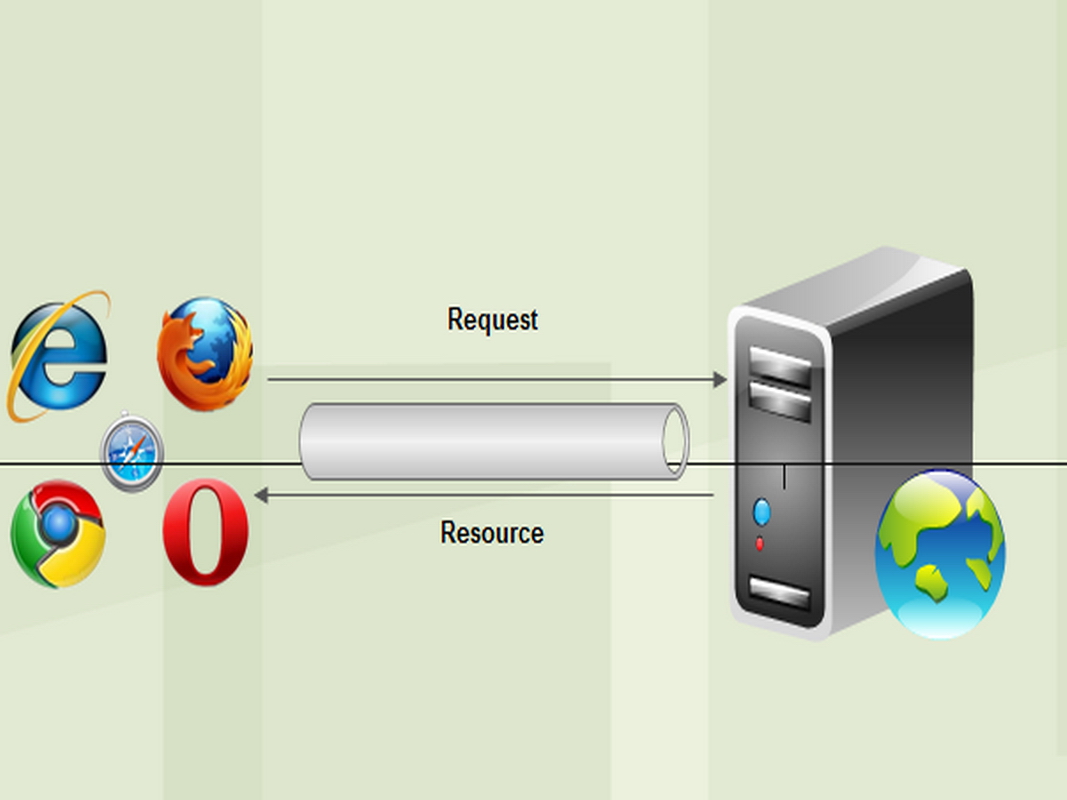
视图函数,围绕着两个对象进行:HttpResponse和HttpRequest
1.HttpRequest
request---->请求信息
属性:
request.path # 获取访问文件路径 request.method属性 #获取请求中使用的HTTP方式(POST/GET)
request.body #含所有请求体信息 是bytes类型
request.GET #GET请求的数据(类字典对象) 请求头中的url中?后面拿值
request.POST # POST请求的数据(类字典对象) 请求体里拿值
request.COOKIES #包含所有cookies的标准Python字典对象;keys和values都是字符串。
request.FILES: 包含所有上传文件的类字典对象;FILES中的每一个Key都是<input type="file" name="" />标签中
name属性的值,FILES中的每一个value同时也是一个标准的python字典对象,包含下面三个Keys:
filename: 上传文件名,用字符串表示
content_type: 上传文件的Content Type
content: 上传文件的原始内容
request.user: 是一个django.contrib.auth.models.User对象,代表当前登陆的用户。如果访问用户当前
没有登陆,user将被初始化为django.contrib.auth.models.AnonymousUser的实例。你
可以通过user的is_authenticated()方法来辨别用户是否登陆:
if req.user.is_authenticated();只有激活Django中的AuthenticationMiddleware
时该属性才可用
request.session: 唯一可读写的属性,代表当前会话的字典对象;自己有激活Django中的session支持时该属性才可用
request.GET.get('name') 拿到GET请求里name的值
如果某个键对应有多个值,则不能直接用get取值,需要用getlist,如:
request.POST.getlist("hobby")
请求url:http://127.0.0.1:8000/index.html/23?a=1
request.path : 请求路径
request.path结果为:/index.html/23
request.get_full_path()
request.get_full_path()结果为:/index.html/23?a=1
方法:
|
1
|
get_full_path() |
注意:键值对的值是多个的时候,比如checkbox类型的input标签,select标签,需要用:
|
1
|
request.POST.getlist("hobby") |
2.HttpResponse
HttpResponse---->相应字符串
对于HttpRequest请求对象来说,是由django自动创建的,但是,HttpResponse响应对象就必须我们自己创建。每个view请求处理方法必须返回一个HttpResponse响应对象。HttpResponse类在django.http.HttpResponse。
在HttpResponse对象上扩展的常用方法
1.render 函数
将指定页面渲染后返回给浏览器
render(request, template_name[, context])
结合一个给定的模板和一个给定的上下文字典,并返回一个渲染后的 HttpResponse 对象。
参数:
request: 用于生成响应的请求对象。
template_name:要使用的模板的完整名称,可选的参数
context:添加到模板上下文的一个字典。默认是一个空字典。如果字典中的某个值是可调用的,视图将在渲染模板之前调用它。
content_type:生成的文档要使用的MIME类型。默认为DEFAULT_CONTENT_TYPE 设置的值。
status:响应的状态码。默认为200。
from django.shortcuts import render def test(request): return render(request,'index.html') #向用户显示一个html页面
下面为render官方源码,可以看出render最后也是返回了一个HttpResponse给webserver
def render(request, template_name, context=None, content_type=None, status=None, using=None): """ Returns a HttpResponse whose content is filled with the result of calling django.template.loader.render_to_string() with the passed arguments. """ content = loader.render_to_string(template_name, context, request, using=using) return HttpResponse(content, content_type, status)
细说render:
render方法主要是将从服务器提取的数据,填充到模板中,然后将渲染后的html静态文件返回给浏览器。这里一定要注意:render渲染的是模板,下面我们看看什么叫作模板:
<!DOCTYPE html> <html lang="en"> <head> <meta charset="UTF-8"> <meta http-equiv="x-ua-compatible" content="IE=edge"> <meta name="viewport" content="width=device-width, initial-scale=1"> <title>Title</title> <style> li,ul,ol{ list-style: none; } a{ text-decoration: none; } </style> </head> <body> <ul> {% for book in list %} <li><a href="{{book.id}}">{{ book.btitle }}</a></li> {% endfor %} </ul> </body> </html>
上面{%%}之间包括的就是我们要从数据库取出的数据,进行填充。对于这样一个没有填充数据的html文件,浏览器是不能进行渲染的,所以,对于上述{%%}之间的内容先要被render进行渲染之后,才能发送给浏览器。
下面举个例子:

<!DOCTYPE html> <html lang="en"> <head> <meta charset="UTF-8"> <meta http-equiv="x-ua-compatible" content="IE=edge"> <meta name="viewport" content="width=device-width, initial-scale=1"> <title>Title</title> <style> li,ul,ol{ list-style: none; } a{ text-decoration: none; } </style> </head> <body> <ul> {% for book in list %} <li><a href="{{book.id}}">{{ book.btitle }}</a></li> {% endfor %} </ul> </body> </html>
def show(request, id): book = BookInfo.objects.get(pk=id) #从数据库中取出对应id的数据 herolist = book.heroinfo_set.all() context = {'list': herolist} # 将数据保存在list return render(request, 'booktest/show.html', context) #通过render进行模板渲染
2.redirect 函数
参数可以是:
- 一个模型:将调用模型的get_absolute_url() 函数
- 一个视图,可以带有参数:将使用urlresolvers.reverse 来反向解析名称
- 一个绝对的或相对的URL,将原封不动的作为重定向的位置。
默认返回一个临时的重定向;传递permanent=True 可以返回一个永久的重定向。
你可以用多种方式使用redirect() 函数。
传递一个对象
将调用get_absolute_url() 方法来获取重定向的URL:
|
1
2
3
4
5
6
|
from django.shortcuts import redirectdef my_view(request): ... object = MyModel.objects.get(...) return redirect(object) |
传递一个视图的名称
可以带有位置参数和关键字参数;将使用reverse() 方法反向解析URL:
|
1
2
3
|
def my_view(request): ... return redirect('some-view-name', foo='bar') |
传递要重定向的一个硬编码的URL
|
1
2
3
|
def my_view(request): ... return redirect('/some/url/') |
也可以是一个完整的URL:
|
1
2
3
|
def my_view(request): ... return redirect('http://example.com/') |
默认情况下,redirect() 返回一个临时重定向。以上所有的形式都接收一个permanent 参数;如果设置为True,将返回一个永久的重定向:
|
1
2
3
4
|
def my_view(request): ... object = MyModel.objects.get(...) return redirect(object, permanent=True) |
跳转(重定向)应用

-----------------------------------url.py url(r"login", views.login), url(r"yuan_back", views.yuan_back), -----------------------------------views.py def login(req): if req.method=="POST": if 1: # return redirect("/yuan_back/") name="yuanhao" return render(req,"my backend.html",locals()) return render(req,"login.html",locals()) def yuan_back(req): name="苑昊" return render(req,"my backend.html",locals()) -----------------------------------login.html <form action="/login/" method="post"> <p>姓名<input type="text" name="username"></p> <p>性别<input type="text" name="sex"></p> <p>邮箱<input type="text" name="email"></p> <p><input type="submit" value="submit"></p> </form> -----------------------------------my backend.html <h1>用户{{ name }}你好</h1>
下面我们来看一个现象:

--------------------urls.py------------------------------ urlpatterns = [ url(r'^admin/', admin.site.urls), url(r'^login/', views.login), url(r'^index/', views.index,), # url(r'^register/', views.register,name='reg'), ] ------------------view.py------------------------------- def login(request): if request.method=='POST': username=request.POST.get('user') password=request.POST.get('pwd') if username=='yuan' and password=='123': # return render(request,'index.html') return redirect('/index/') else: return render(request,'login.html',{'info':'账号或密码错误'}) else: return render(request,'login.html') def index(request): name='yuan' return render(request,'index.html',{'a':name}) ---------------login.html-------------------------------- <h1>登陆界面</h1> <form action="/login/" method="post"> <p>姓名 <input type="text" name="user"></p> <p>密码 <input type="password" name="pwd"></p> <p><input type="submit"></p> <p>{{ info }}</p> </form> ---------------login.html-------------------------------- <h1>个人主页</h1> <h2>hello,{{ a}}</h2>
首先,启动服务器后,我们进入login页面
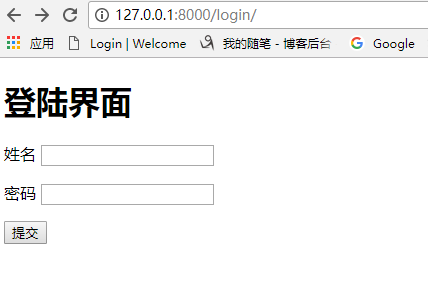
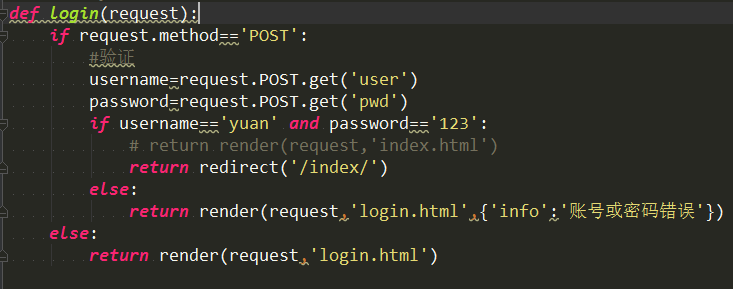
正确输入姓名,密码后,此时执行redirect函数,结果如下
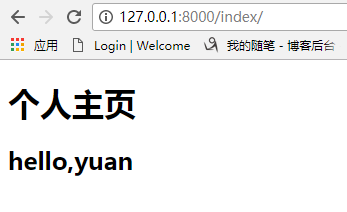
现在我们将redirect换成render,再重新走一遍看看,在login页面,正确输入姓名,密码后,结果如下:

细心的人会发现,用render函数执行后的,地址栏的地址没有变化,还是login,且页面上的{{a}}此时也没有被渲染,所以hello,后面没有内容显示!
对比render与redirect:
原因是
render: 只是返回页面内容,但是未发送第二次请求
redirect:发送了第二次请求,url更新
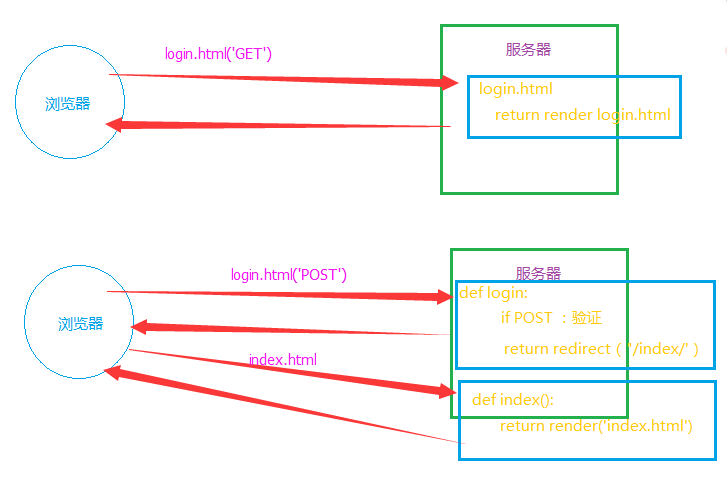
总结两者区别:
第一,render返回一个登陆成功后的页面,刷新该页面将回复到跳转前页面。而redirect则不会
第二,如果页面需要模板语言渲染,需要的将数据库的数据加载到html,那么render方法则不会显示这一部分,render返回一个登陆成功页面,不会经过url路由分发系统,也就是说,不会执行跳转后url的视图函数。这样,返回的页面渲染不成功;而redirect是跳转到指定页面,当登陆成功后,会在url路由系统进行匹配,如果有存在的映射函数,就会执行对应的映射函数。
